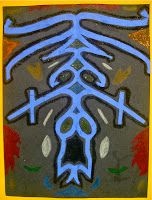We read and discussed "The First Starry Night" written and illustrated by Joan Shaddox Isom. The book is a fictional account of the artist Vincent van Gogh's real life short stay in Arles, France.
Isom's illustrations for her book were inspired by Van Gogh, and so were ours. We used short lines and overlapping colors to create movement in our artwork.
Van Gogh often painted his emotions. He used bright yellows, oranges, and gold to express happiness (see "Sunflowers"), and many shades of blue were used to express a calmness or sadness (see "Starry Night").
Vincent van Gogh painted hundreds of paintings, including three versions of "Starry Night" and countless "Sunflowers", but he only sold one painting during his lifetime.
Oh, he also cut off a piece of his left ear in a fit of rage. Yikes!

















































